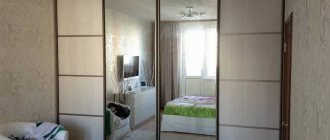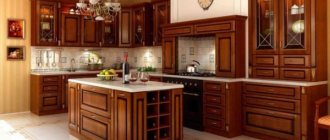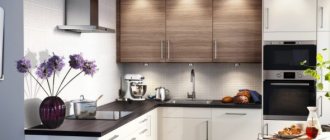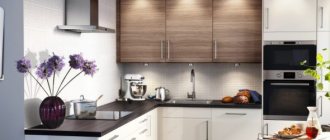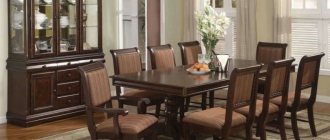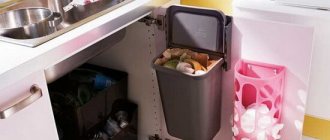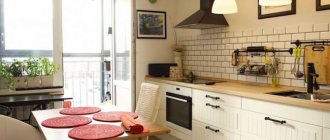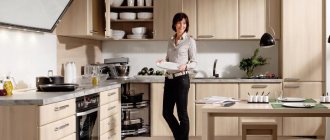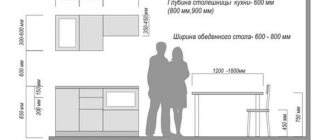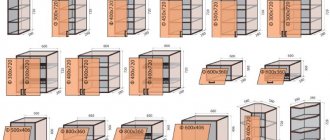Any housewife wants to have an ideal kitchen, to feel comfortable and cozy in it, where every thing is in its place, and the shelves are not filled with dishes and kitchen utensils in a chaotic manner. When choosing a kitchen cabinet for dishes, stick to the golden mean: there should not be too much furniture so as not to clutter the space. At the same time, all cabinets should be as functional as possible, since some of them do an excellent job of storing kitchen utensils, others - with placement of large or small household appliances, and still others contain canned goods and food supplies. In addition, if you are selecting a cupboard for an existing kitchen set, it should fit well with the overall design of the kitchen.
Peculiarities
The practical need for any kitchen cabinets is quite great. Since it is important to use all the space rationally in the kitchen, it is not recommended to clutter it with unnecessary items. Dishes can be stored in kitchen areas in different ways:
- on open shelves, which is not very practical, as dust settles on objects;
- placing on shelves - rational, but again not practical;
- put it in the kitchen chest of drawers - the advantage is that the items are in closed drawers, but it is inconvenient for everyday use;
- distributing for storage in a kitchen cabinet is an ideal option, all items are at hand, reliably protected by doors or closing facades from contamination.
The benefits are as follows:
- the dishes remain clean;
- does not interfere with work in the kitchen;
- All accessories have their place, perfect order is maintained in the kitchen.
The kitchen cupboard has a number of its own features for its rational distribution and convenient storage:
- a cabinet (usually a floor-mounted one) with solid doors;
- with transparent glass doors;
- having a roll-out drawer for cutlery;
- with mechanical brackets that allow the door to be lifted up or parallel to the cabinet;
- with a facade that can be folded into a book shape.
With glass doors
With a blank facade
With lifting mechanism
Roll-out
Material for production
Wood, plastic, chipboard, MDF, glass or metal are used to make cabinets.
Thus, the buyer has the right to choose when choosing furniture to suit his interior, taste or depending on his financial situation.
Kinds
The range of cupboards available on the market is huge. There are five main types of cabinets where you can conveniently store any kitchen utensils, including dishes:
- hanging - does not clutter up the space, the best option for small kitchens and families where they are used to making do with a minimum amount of dishes;
- corner cabinet - compact and deep, able to fit into any room, significantly saves space;
- buffet - perfect for a kitchen decorated in a retro style, vintage or artificially aged thanks to special technologies, functional, since there is an upper compartment with a glass facade, a lower one with blind doors and an open shelf for decorative items;
- showcase - the cabinet is fully equipped with glass facades and is open for viewing from top to bottom, so there is no place for pots and pans in such a cabinet; the owners use it as an element for decorating the kitchen, displaying collectible vases, sets, and souvenirs on the shelves;
- sideboard - in modern design solutions it looks little like a relic of the Soviet past, such a two-level cabinet with glass sections on top and many drawers below is designed for storing dishes, cutlery and serving items; we can say that sideboards take on a new life.
Buffet
Showcase
Suspension
Sideboard
Angular
Filling
The next most important point when buying china cabinets is their proper filling. The question of what devices to pay attention to when choosing, so that all items stored and used in the kitchen find their place and are not scattered chaotically on surfaces and shelves, is relevant for every housewife. To conveniently place dishes, essentials, jars of bulk products, vases with sweets and decorative items behind the doors and facades of furniture sets, furniture manufacturers offer a lot of ergonomic options:
- an open shelf is convenient because you don’t need to hold the doors when opening and everything you need is at hand, suitable for storing jars of seasonings, regularly used dishes, cutlery (ladles, skimmers), and decorative items; the disadvantage is that such shelves are not spacious enough, they require perfect order and careful care due to the constantly accumulating dust;
- a dish dryer is a must-have for the kitchen; it is usually placed in a closed cabinet compartment, thanks to which kitchen utensils dry quickly;
- Roll-out metal structures have been created specifically for storing small dishes;
- retractable grids and baskets - significantly save space in the room, facilitating access to food, dishes and other accessories, helping to manage space in the kitchen wisely;
- bottle holder - a narrow, long pull-out module at the height of floor cabinets with metal devices for storing bottles;
- carousel shelf - effectively uses the space of corner sets, allows you to place even large objects, pots, pans;
- the system of drawers is a very convenient element of modern kitchen furniture, especially in the internal space of the corner cabinet, when when you open the door, several shelves smoothly “move out” in steps; such a “magic corner” is simply an invaluable device for its practicality;
- railing systems - can be located inside cabinets or outside along the kitchen wall under wall-mounted modules; all kinds of shelves with hooks, cups, ladles, potholders, skimmers, containers with spices are conveniently attached to them;
- design for storing plastic lids - mounted on the cabinet door, thanks to which lids from food containers can be compactly stored separately from containers;
- A vintage wooden box will help diversify the interior, where you can easily place cutting boards.
In addition, there are a lot of devices for storing cutlery; plastic or wooden trays and magnetic knife holders are placed in the kitchen cabinet.
Drawers can be divided into many sections, where it is convenient to place kitchen utensils. Under the countertop is the right place for a retractable cutting board; below it is worth placing removable trays and containers.
Shape and dimensions
The parameters of cupboards must correspond to the size of the kitchen; their shape is varied; choosing a piece of furniture according to your preferences is both easy and difficult. A large kitchen makes it possible to purchase a solid kitchen set, where a significant amount of space is allocated to cupboards, where to put a beautiful display case, and to properly distribute all the utensils available in the house. Owners of a small-sized kitchen, before choosing one or another item, should think about options for compact placement of furniture.
The standard sizes of cupboards depend on their location. So, by attaching a wall cabinet to a free wall, you will significantly save space, while wisely choosing the filling for the cabinet, you will be able to place most of the dishes there. Standard sizes range from 30 to 90 cm in height, the depth reaches 30 cm (half the size of the tabletop). The proposed dimensions are not always suitable for the kitchen space; in this case, you will have to make custom-made furniture according to the required dimensions.
Some practical tips:
- The greater the depth of the wall cabinet, the stronger and more reliable the fastenings must be, otherwise you risk being injured if the cabinet does not stay on the wall. Optimal width and height – 30-35 cm;
- a high module is not practical, since it will be difficult to use dishes that are stored on the upper shelves; getting them out will be problematic. It is more convenient to place dishes equally in the upper and lower small cabinets;
- if you plan to install a drying dish in a wall cabinet, then its depth should correspond to the diameter of the largest plate;
- It is best to use cabinets of different heights in the kitchen: with open shelves for decorative items, with glass for dishes, with blind doors where you can put larger utensils and hide them from prying eyes.
The greater the depth of the wall cabinets, the more the kitchen needs additional lighting, since the modules darken the work surface. It is worth taking care to install spotlights on the bottom of the cabinet.
Floor cabinets are designed for storing dishes; they usually have drawers where cutlery is located, as well as for built-in household appliances. Their shape and dimensions correspond to the rest of the kitchen furniture modules.
A corner cabinet is an excellent solution for a small kitchen; it takes up little space (the most unused part of the room is the corner), while significantly saving space. There are open and closed, straight and semicircular shapes. A rotating metal structure will fit perfectly into such cabinets; therefore, access to the items stored there will be easier.
As for buffets, sideboards and display cases - here the flight of your imagination and the creativity of designers is not limited, the only obstacle is the kitchen area; it is difficult to place such furniture in a small room. Although small display cases and sideboards can look quite harmonious even in a modest kitchen.
Designs of wall cabinets for storing dishes
In addition to the stylistic design, an equally important aspect is the design of the furniture. There are two main types of structures:
- linear;
- corner
Linear modules are hung on straight sections of walls and are a classic cabinet with shelves, equipped with one or two doors. Straight cabinets can have a horizontal or vertical design. In the first case, the linear module is equipped with special mechanisms that ensure opening and maintaining the cabinet door in a horizontal position. Vertical linear models are simpler and more accessible.
Corner cabinets are used with an L-shaped or U-shaped layout and are located in the corner of the room. The main advantages of corner hanging modules are large capacity and ergonomics. Based on their geometric shape, corner cabinets are divided into rectangular, trapezoidal and L-shaped models.
Standard sizes of wall cabinets for dishes:
- depth – 300 mm;
- width – from 300 to 1200 mm;
- height – 360.720 or 920 mm.
Rules of care
Since the kitchen area is constantly exposed to moisture and fumes during cooking, it is worth selecting furniture of high-quality materials, it is equally important to treat it with care, following the rules of care, do not cut food on the surface, but use a special cutting board, do not slam the folding panels, do not pull them out sharply drawers, regularly treat them with detergents, among other things:
- furniture should be protected from direct sunlight;
- When cleaning cabinets, do not use aggressive detergents;
- It is better to wipe plastic panels with a damp cloth, wooden panels with a dry cloth;
- for deeper cleaning of wooden surfaces, use a cloth soaked in water with a diluted degreaser; after cleaning, be sure to wipe dry;
- Wash stainless steel parts with soapy water, then wipe with a dry cloth;
- Clean glass facades with a special cleaner;
- the weight in wall cabinets should be distributed evenly; also, you should not overload shelves and roll-out drawers (there is a risk of rapid wear of the drawers);
- Avoid shock, mechanical damage, exposure to water and steam;
- It is better not to place cupboards above the hob;
- to maintain the aesthetic appearance of wooden (chipboard, MDF) surfaces, it is worth using a polish, preferably with the addition of wax;
- Make sure that moisture and condensation do not accumulate on surfaces.
To ensure that your utensil cabinets fit perfectly into your kitchen interior, use some recommendations:
- select modules in accordance with the design of the room (according to color scheme, style), furniture made in a modern style is very laconic in form, classic, retro, Provence suggest the purchase of more elaborate and large furniture items;
- a small or dimly lit room requires light shades;
- all furniture in the kitchen is subject to temperature changes and excessive moisture, so the materials used for its manufacture must be of high quality, heat and moisture resistant;
- fittings and fastenings must be reliable and designed for a long service life;
- if you equip roll-out drawers with closers and shock absorbers, they will slide out silently;
- glass for display cases and cabinets - at least 4 mm thick, durable and tempered, internal lighting will effectively highlight the beauty of the dishes placed there;
- the dimensions of kitchen cabinets for dishes must correspond to the size of the room; before buying (making to order) a module, decide what dishes you will store there and in what quantity;
- be sure to use additional lighting - it’s convenient, beautiful, aesthetically pleasing;
- shelves and drawers should be stable; if your kitchen has uneven floors, you should consider buying furniture with adjustable legs;
- The glass fronts of the cabinets look stylish with a sandblasted pattern.
Each type of kitchen cabinet for dishes is convenient and functional; it is worth selecting it according to the technical characteristics, size, style of each individual room and its design as a whole. All pieces of furniture should be harmoniously combined with each other, have practical value and create a comfortable atmosphere in the kitchen.
Opening systems for wall cabinets
An important element of the top row kitchen modules is the door opening and closing system. In the designs of wall cabinets, the following facade opening mechanisms are used:
- swing,
- sliding,
- lifting
Swing opening systems impress with their simplicity of design, long service life, repairability and low price. The front is attached to the cabinet body using hinges. Modern swing systems can be equipped with closers that ensure smooth door movement. The use of improved fittings increases the cost of the structure as a whole.
Sliding systems, unlike swing mechanisms, do not require free space to open the doors. The door leaf will move to the side along the guides. Sliding facades are the best solution for small kitchens.
The operating principle of lifting systems is based on the use of hydraulic mechanisms. Gas or spring shock absorbers ensure a smooth rise of the facade upwards, the door is held in the open position for the required amount of time. Depending on the fittings used, kitchen cabinet doors can be raised completely or to a specified level.
